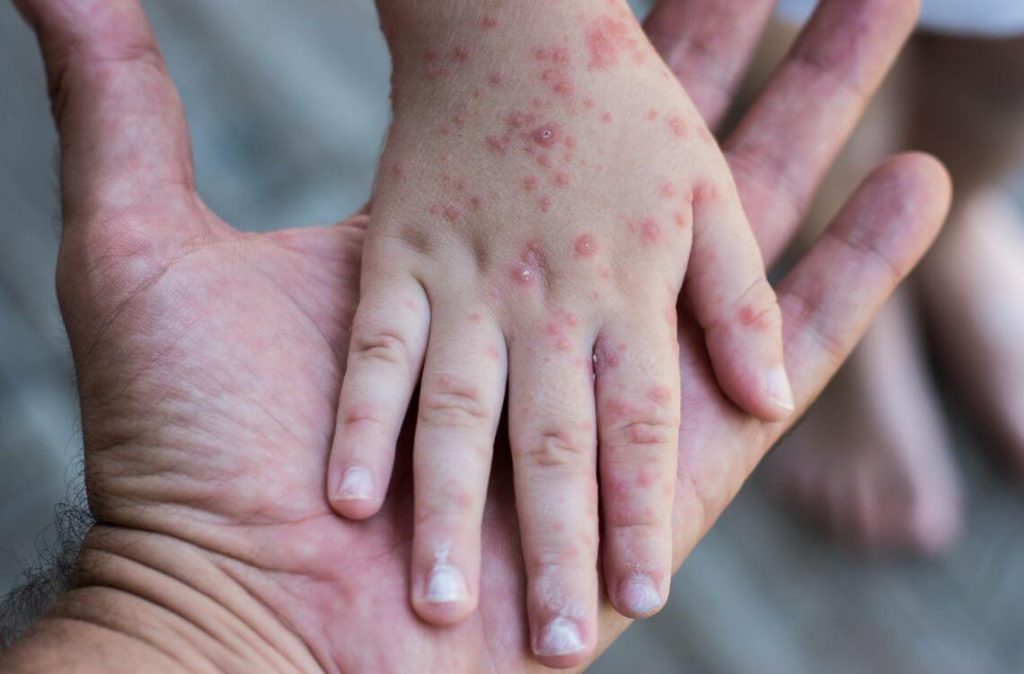Hand, foot and mouth disease (HFMD) is very common among young children. It can infect your baby as well.
It is not fatal, but should be cured immediately to avoid pain and discomfort.
What is Hand, Foot and Mouth Disease (HFMD)
Hand foot and mouth disease (HFMD) is a viral infection that is mild yet contagious. It usually affects young children and babies.
Symptoms of HFMD include sores around the mouth and a nasty rash on the hands and feet. There could also be blisters and peeling skin.
Some other side effects are:
- Fever
- Sore throat
- Fatigue
- Fussiness
- Loss of appetite
In severe cases, which are quite rare, there may be sores or blisters on the hands and feet.
Sores at the back of the throat can indicate herpangina, a related viral illness that can lead to seizures.
HFMD typically lasts for just a few days, so unless it develops into a more serious matter, there is usually nothing to worry about.
How Hand, Foot and Mouth Disease Spreads
HFMD is caused by a group of viruses called the coxsackieviruses. The most common type is Coxsackievirus A16.
It is a contagious disease that spreads through all manner of contact.
The main mode of infection is from nasal discharge and respiratory droplets that spray into the air when someone sneezes or coughs.
A few other ways HFMD can spread is through saliva, stool, as well as the fluid from blisters.
The best way to avoid infection is to avoid any bodily fluids from anyone who is infected.
This is one of the reasons HFMD is so prolific among children; some may not take very good care of their hygiene. Be extra careful if your child attends a childcare centre or kindergarten.
The incubation period of the virus is around three to six days, so it may be a while before you notice symptoms in your baby.
Once you do, immediately remove them from any spaces where they could potentially infect others.
Treatment for Hand, Foot and Mouth Disease
The best option for controlling HFMD is taking preventative measures. As they say, prevention is better than cure.
The number one rule of hygiene is to always wash your hands.
Every time you take your baby out of the house or they come into contact with unsanitary substances, wash their hands; or better yet, give them a bath.
Always be careful in public spaces and keep sanitiser, wet wipes and tissues on hand.
There isn’t any specific medication for HFMD. Instead, you can take measure to treat the symptoms of the disease until your baby gets better.
Keep your baby hydrated and feed them well during their illness. You should also let them rest and regain their energy.
A topical oral anaesthetic may help relieve the pain of mouth sores. You can also apply a soothing lotion to the rash on their hands and legs.
Symptoms of hand-foot-and-mouth disease usually clear up in seven to 10 days, so your baby should be back to normal within two weeks.
If the symptoms persist, contact your paediatrician.
What Comes Next
As HFMD is a treatable disease and has no lasting effects, there is no reason to worry once your baby is on the road to recovery.
It can recur, but with sufficient monitoring and care you will be able to treat your baby once again.
Disclaimer: The information provided in this article is for informational purposes only and should not be considered as medical advice from Motherhood. For any health-related concerns, it is advisable to consult with a qualified healthcare professional or medical practitioner.
For more insightful stories and fun recipes, stay tuned to Motherhood Story!
